Your bedroom walls are blank canvases awaiting transformation—silent but powerful elements that can completely change how your personal sanctuary feels. Yet many of us neglect these valuable surfaces, focusing instead on furniture and textiles. The truth is, thoughtful wall decoration is often what seprates a stunning bedroom from a merely functional one.
According to a 2024 interior design survey by Home & Design Magazine, bedrooms with intentionally decorated walls were rated 37% more “restful” and “inspiring” by occupants than those with minimal wall treatment. It’s not just about aesthetics—it’s about creating a space that nurtures your wellbeing.
In this guide, we’ll explore 22 creative bedroom wall decoration ideas that range from simple weekend projects to stunning statement pieces. Whether you’re working with a modest budget or ready for a significant investment, you’ll find inspiration to elevate your space and transform those empty walls into expressions of your personal style.
Understanding Wall Decoration Fundamentals
Before diving into specific ideas, let’s establish some fundamental principles that will help you make thoughtful decorating decisions.
The Psychology of Bedroom Walls
The colors, textures, and images we surround ourselves with profoundly impact our mood and sleep quality. Environmental psychologist Dr. Elena Martinez explains, “Bedroom walls occupy the largest visual field in your resting space. Their treatment directly affects stress levels, ability to relax, and even sleep patterns.”
Cool tones like soft blues and greens have been shown to lower heart rates and blood pressure, while warmer hues create feelings of security and comfort. Patterns and textures add visual interest but should be balanced against your need for restfulness.
Assessing Your Space
Take time to observe how light moves through your bedroom throughout the day. South-facing rooms receive consistent natural light and can handle bolder wall treatments, while north-facing spaces might benefit from lighter colors and reflective elements to maximize limited light.
Consider the architectural features of your room—sloped ceilings, windows, doorways—and how they might interact with your wall decor. Measure your walls and ceiling height precisely; scale is crucial for successful wall decoration.
Finding Your Personal Wall Style
Interior designer Morgan Chen suggests, “Your bedroom walls should tell your story, not just follow trends. Consider what images, colors, and textures make you feel most at peace.”
Ask yourself:
- Do you prefer minimalist spaces or more layered, collected looks?
- Are you drawn to bold colors or soothing neutrals?
- Do you value changeable elements or prefer permanent installations?
- What mood do you want to cultivate—energizing, calming, romantic, playful?
With these considerations in mind, let’s explore our 22 wall decoration ideas.
Large-Scale Statement Ideas
1. Oversized Artwork as a Dramatic Focal Point
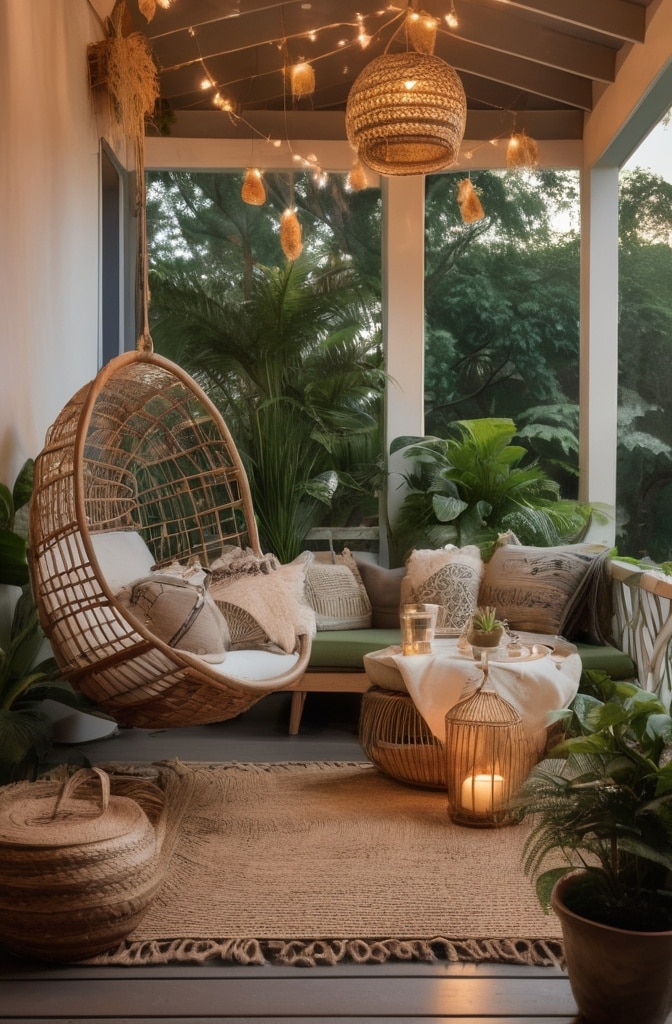
An oversized piece of art commands attention and anchors a room with minimal effort. Rather than crowding walls with multiple small pieces, consider investing in one significant work.
“Large-scale art is actually a shortcut to a designed-looking space,” notes gallery owner Petra Simmons. “It creates instant impact and can carry a room with very little additional decoration.”
When selecting oversized art:
- Choose a piece that’s at least 2/3 the width of the furniture it hangs above
- Hang at eye level (typically center at 57-60 inches from the floor)
- Select frames that either complement or intentionally contrast with your decor
- Consider the emotional tone of the piece—bedrooms benefit from art that evokes feelings you want to experience while resting
Personal tip: If original art exceeds your budget, many artists offer high-quality, limited-edition prints at more accessible price points. Sites like Society6 and Saatchi Art provide wide selections across price ranges.
2. Bold Accent Walls That Transform Spaces
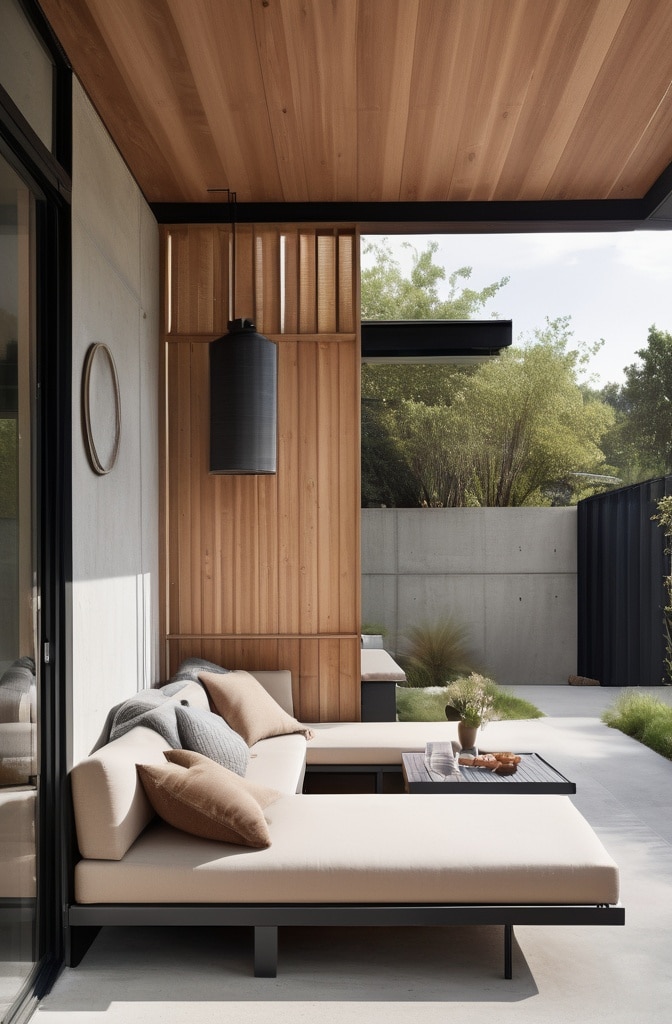
An accent wall uses color, pattern, or texture to create a focal point that enhances your bedroom’s architecture. According to the National Association of Home Builders, accent walls remain one of the highest ROI interior updates, with 89% of potential buyers responding positively to thoughtfully executed examples.
Designer Katie Lewis suggests, “When choosing an accent wall, select the one that first catches your eye when entering the room, or the wall behind your headboard, which naturally draws attention.”
Popular accent wall approaches for 2025 include:
- Two-tone color blocking with complementary hues
- Geometric patterns achieved through paint or wallpaper
- Nature-inspired botanical prints for serene spaces
- Moody, dramatic dark tones paired with metallic accents
For renters or the commitment-averse, removable wallpaper has evolved dramatically in quality and selection. Brands like Chasing Paper and Tempaper offer sophisticated designs that install and remove without damage.
Read This Blog: https://hometranquil.com/these-green-living-room-22-ideas/
3. Textured Wall Panels for Dimensional Interest
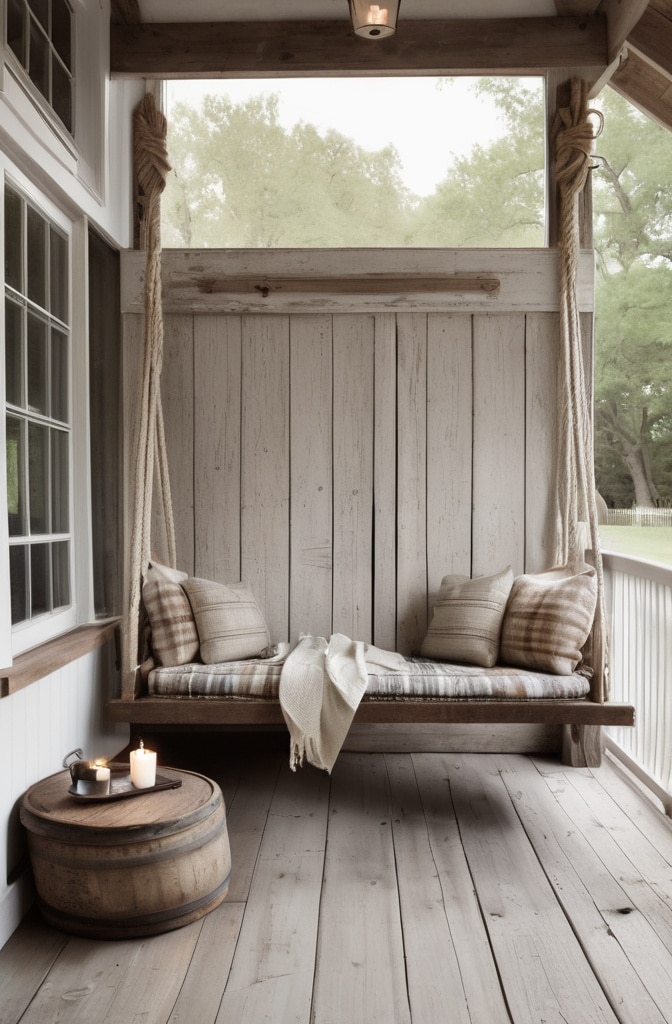
Three-dimensional wall treatments add sophistication and sensory richness that flat surfaces simply cannot match. These panels create shadow play as light changes throughout the day, bringing walls to life with subtle movement.
Popular texturing options include:
Wood panels: Warm and organic, wood panels range from rustic reclaimed styles to sleek, geometric modern designs. Companies like Stikwood offer peel-and-stick real wood panels that simplify installation.
3D wall panels: Made from materials like PVC, MDF, or eco-friendly plant fibers, these molded panels come in countless patterns from subtle waves to bold geometric reliefs. They’re particularly effective when painted a single color, allowing shadows to create the visual interest.
Fabric-wrapped panels: These sound-absorbing panels improve room acoustics while adding softness. They’re ideal for bedrooms that feel echoey or in multi-family dwellings where sound transmission is a concern.
“Textured walls create an immediate sense of luxury,” explains interior architect Jamil Rodriguez. “They transform flat surfaces into architectural features without major construction.”
4. Statement Headboards That Double as Wall Art
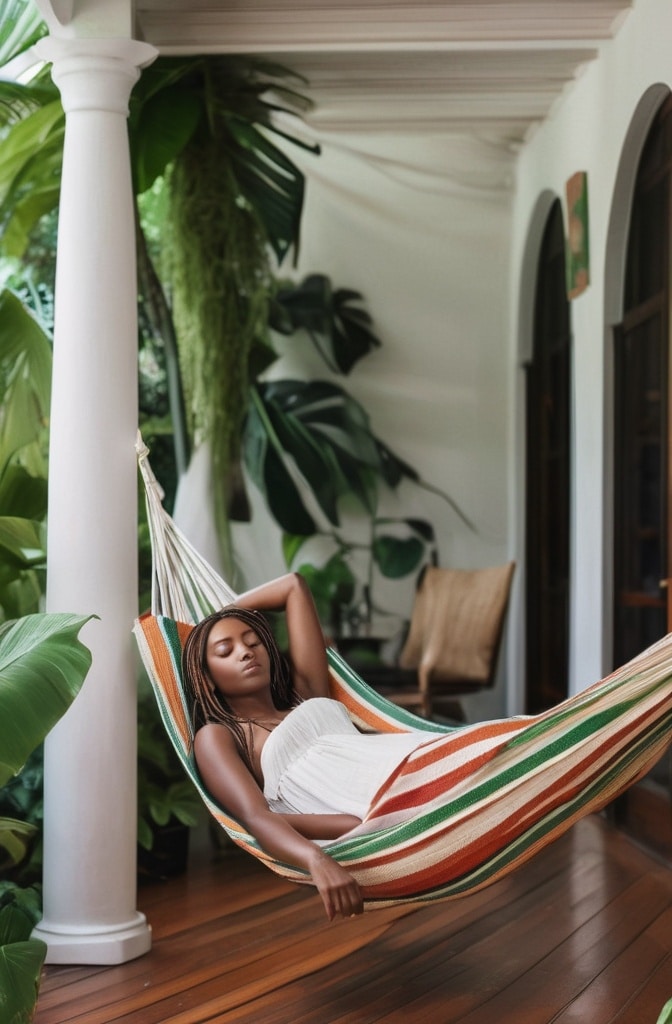
When floor space is limited, vertical thinking saves the day. Statement headboards that extend beyond traditional proportions create dramatic impact while functioning as both furniture and wall decor.
Extended headboards can:
- Create a sense of height in rooms with low ceilings
- Define the bed area in open-plan spaces
- Incorporate built-in nightstands or shelving
- Feature integrated lighting for reading
Materials trending for statement headboards include channel-tufted velvet, natural rattan, leather panels, and slim wood slats with integrated lighting. For DIY enthusiasts, upholstered headboards offer achievable projects with high-impact results.
Personalized Wall Gallery Concepts
5. Curated Gallery Walls With Personal Photographs

Gallery walls transform personal memories into intentional decor. The key lies in thoughtful curation and arrangement.
“A successful gallery wall tells a visual story,” explains photographer and stylist Aiden Park. “It should feel collected rather than cluttered, with a unifying element tying diverse pieces together.”
That unifying element might be:
- A consistent color scheme or filter across photos
- Matching or coordinating frames
- A thematic connection between images
- A balanced composition with varied sizes but visual harmony
When planning your layout:
- Arrange frames on the floor first to experiment with composition
- Start with a central anchor piece and build outward
- Maintain consistent spacing (2-3 inches generally works well)
- Consider using paper templates taped to the wall before hammering any nails
Online services like Framebridge and Artifact Uprising specialize in helping create cohesive gallery walls, offering design consultation and coordinated framing packages.
6. Framed Botanical Prints for Natural Serenity
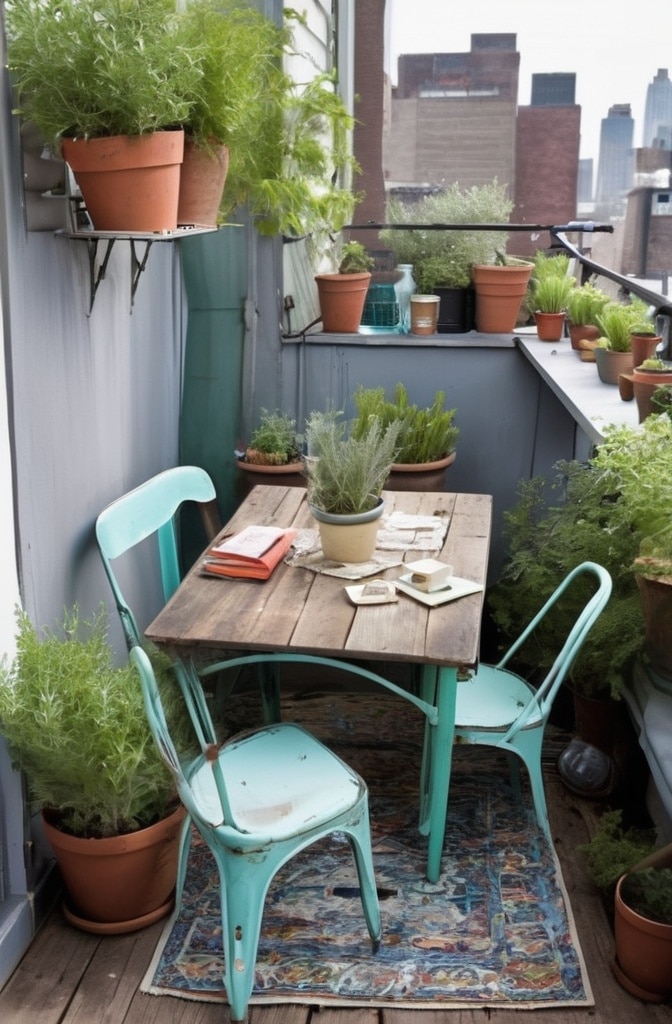
Botanical prints bring the calming influence of nature indoors—perfect for creating a restful bedroom environment. Research published in the Journal of Physiological Anthropology confirms that even images of plants can reduce stress and promote wellbeing.
Vintage botanical prints carry historical charm, while contemporary botanical photography offers crisp, modern interpretations. For unique options:
- Browse digital archives of historical botanical illustrations (the Biodiversity Heritage Library offers thousands of public domain images)
- Support botanical artists on platforms like Etsy for original works
- Consider preserved plant specimens professionally framed for dimensional interest
Designer Tip: For maximum impact, group botanical prints in thematic collections—varieties of ferns, tropical leaves, or flowers from a specific region.
7. Vintage Maps and Travel Memorabilia Displays
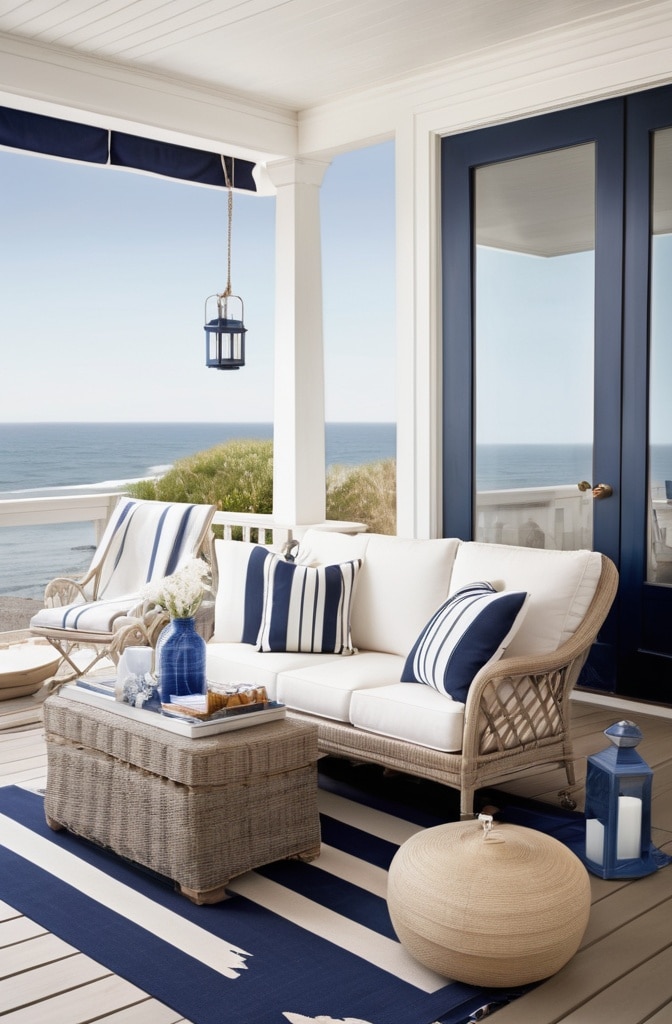
Maps transform bedroom walls into launchpads for dreams and memories. Whether you display destinations visited or places you aspire to see, map displays create personal connection and visual interest.
Cartographer and design consultant Eliza Wong suggests, “Maps are never just about geography—they’re about personal history, heritage, and aspirations. The most compelling map displays incorporate these personal elements.”
Consider these approaches:
- Frame a vintage map of your hometown, birthplace, or ancestry regions
- Create a wall highlighting favorite travel memories with maps accented by small framed photos or souvenirs
- Use a world map and subtle markers to indicate places visited or bucket list destinations
- Frame historical maps showing how familiar places have changed over time
For preservation, UV-protective glass is essential for vintage maps, preventing fading and paper degradation.
8. Inspirational Quotes and Typography Art
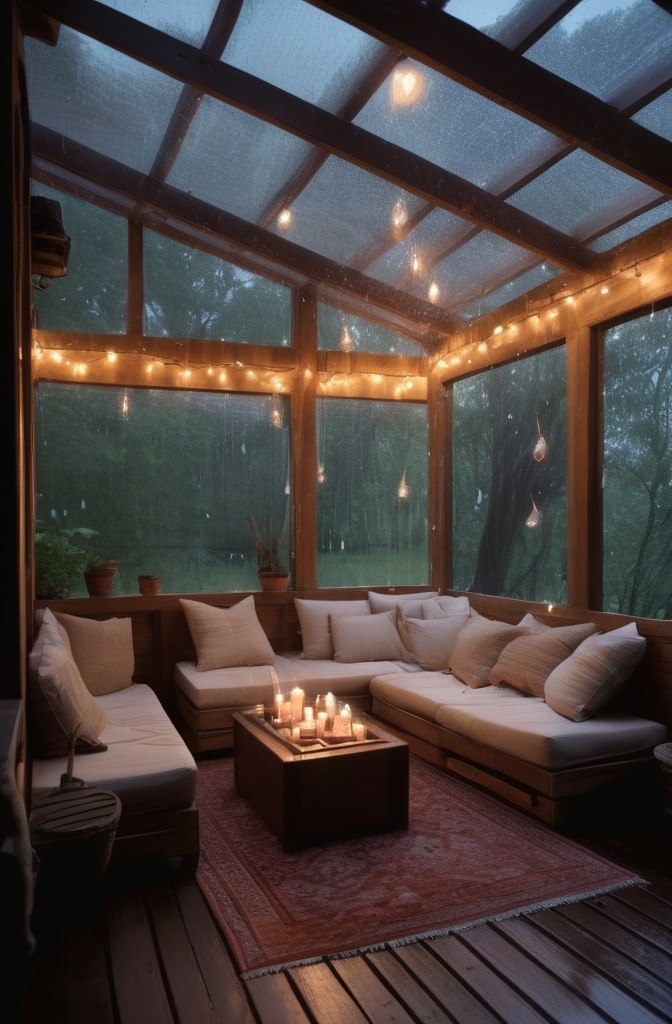
Words hold power—especially in spaces where we begin and end each day. Thoughtfully chosen text can set intentions, provide comfort, or inspire.
Typography artist Marcos Rivera notes, “The bedroom is where many people set their mindset for the day or reflect before sleep. Text art here should be chosen with particular intention.”
When incorporating text art:
- Choose phrases that genuinely resonate rather than generic expressions
- Consider the visual weight of the text—it should harmonize with other elements
- Select fonts that reflect the emotion behind the words
- Think about scale—a single powerful word can be more effective than a lengthy quote
For truly personal impact, consider commissioning a calligrapher to create custom text art featuring meaningful passages, wedding vows, or family mantras.
Textural and Three-Dimensional Options
9. Hanging Tapestries for Warmth and Acoustics
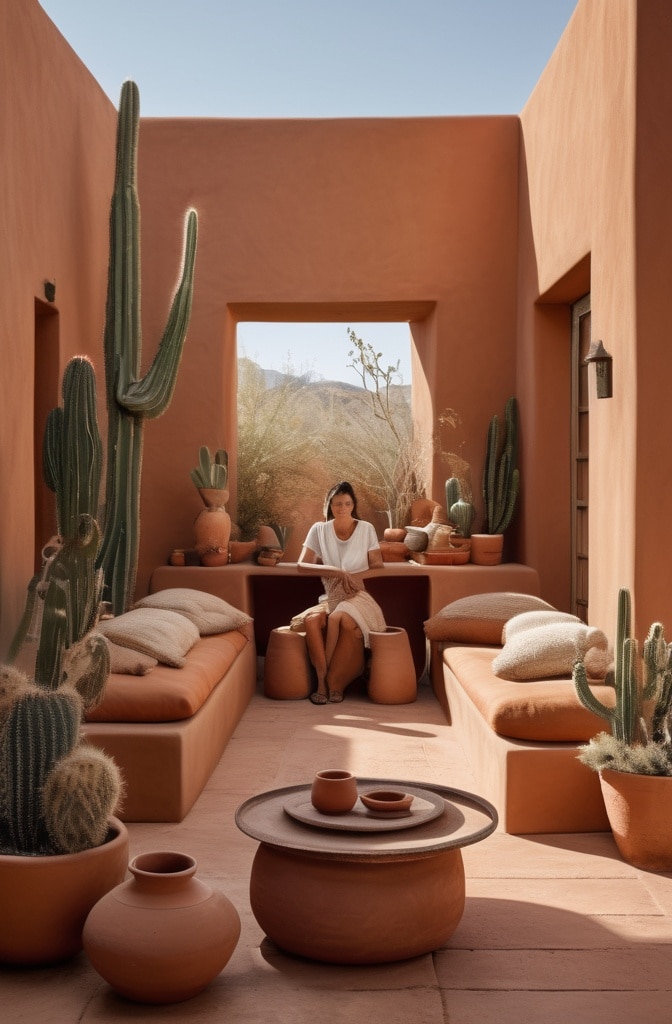
Textiles on walls add unmatched softness to bedroom spaces while improving room acoustics. Modern tapestries range from traditional woven pieces to contemporary fiber art, offering options for every aesthetic.
“Wall textiles change the entire sensory experience of a room,” explains textile artist Neha Sharma. “They absorb sound, creating a quieter space conducive to rest, while adding visual warmth that hard surfaces cannot provide.”
When selecting and hanging tapestries:
- Choose appropriate scale—larger pieces create more impact and better acoustic benefits
- Install with consideration for fabric weight using appropriate hardware
- Consider using tapestry rods, which allow fabric to hang with gentle natural movement
- In smaller rooms, select lighter colors and less busy patterns to maintain spaciousness
For rental-friendly installation, tension rods or command hooks designed for heavier items offer damage-free options.
10. Macramé Wall Hangings for Bohemian Texture
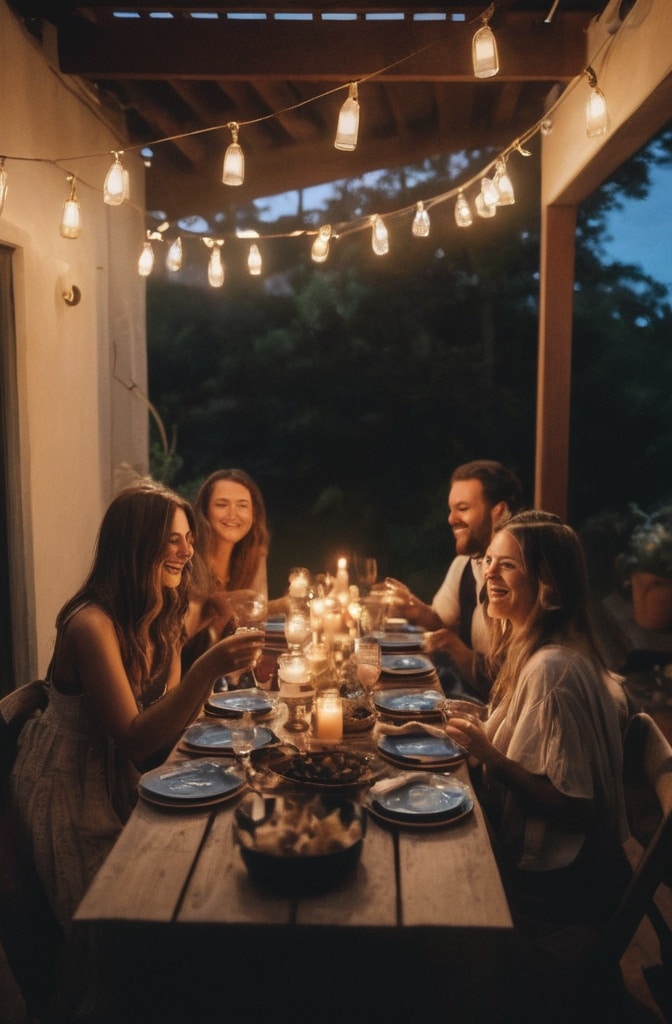
Macramé has transcended its 1970s associations to become a sophisticated textile art form. Modern macramé often features subtler palettes and more minimalist designs than its vintage counterparts.
These knotted creations add dimension and movement to bedroom walls. Their natural fibers contribute organic texture that contrasts beautifully with smooth painted surfaces.
“The beauty of macramé lies in its interplay of negative space and texture,” notes fiber artist Jodie Chen. “It adds interest without overwhelming a restful space.”
When incorporating macramé:
- Consider scale carefully—pieces should balance with other wall elements
- Choose fiber colors that complement your overall palette (undyed cotton and jute offer versatile neutrals)
- Look for unique shapes beyond the standard triangle—circles, asymmetrical forms, and wall pockets add visual interest
- Consider macramé with integrated functions like plant hangers or small storage elements
For the crafty, macramé basics are relatively accessible to learn, making this a satisfying DIY possibility.
11. Floating Shelves as Functional Art Displays
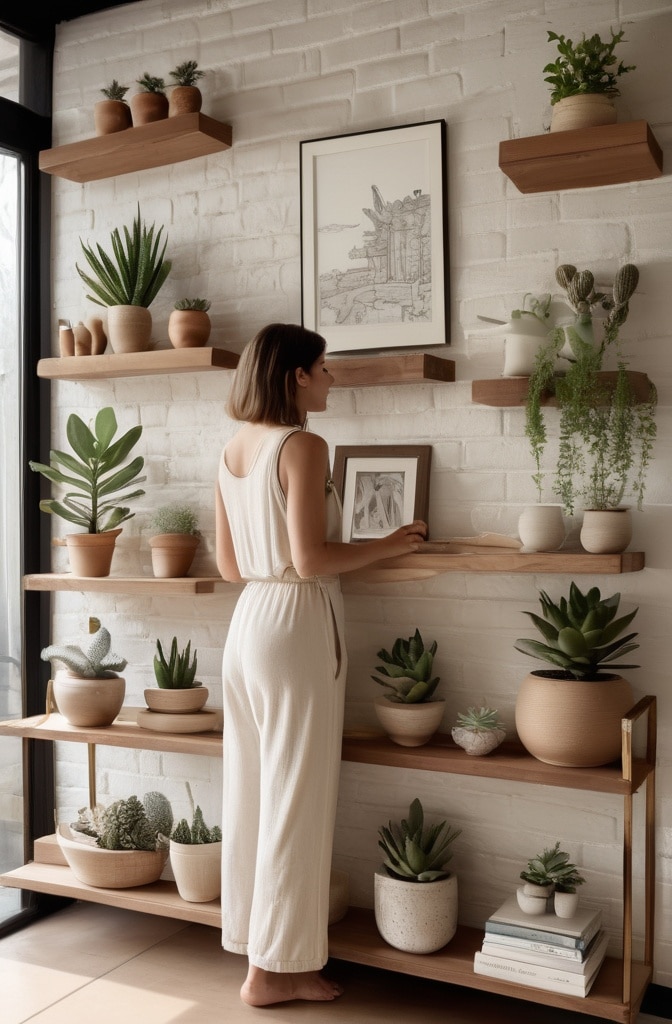
Floating shelves transform everyday objects into curated displays while providing practical storage. In bedrooms, they’re perfect for housing books, small plants, and personal mementos.
“The key to successful display shelving is editing,” advises stylist Tara McKenna. “Select items that bring genuine joy or serve a purpose—avoid clutter that creates visual noise in your resting space.”
For effective floating shelf displays:
- Vary heights, widths, and depths of objects for dimensional interest
- Create visual “moments” with small groupings rather than evenly spacing items
- Incorporate negative space to let arrangements breathe
- Include a mix of textures—smooth ceramics, rough stone, soft textiles, and organic elements
Installation tip: Always locate studs or use appropriate wall anchors—a fully styled floating shelf can weigh significantly more than you might expect.
12. Hanging Plants and Living Wall Features
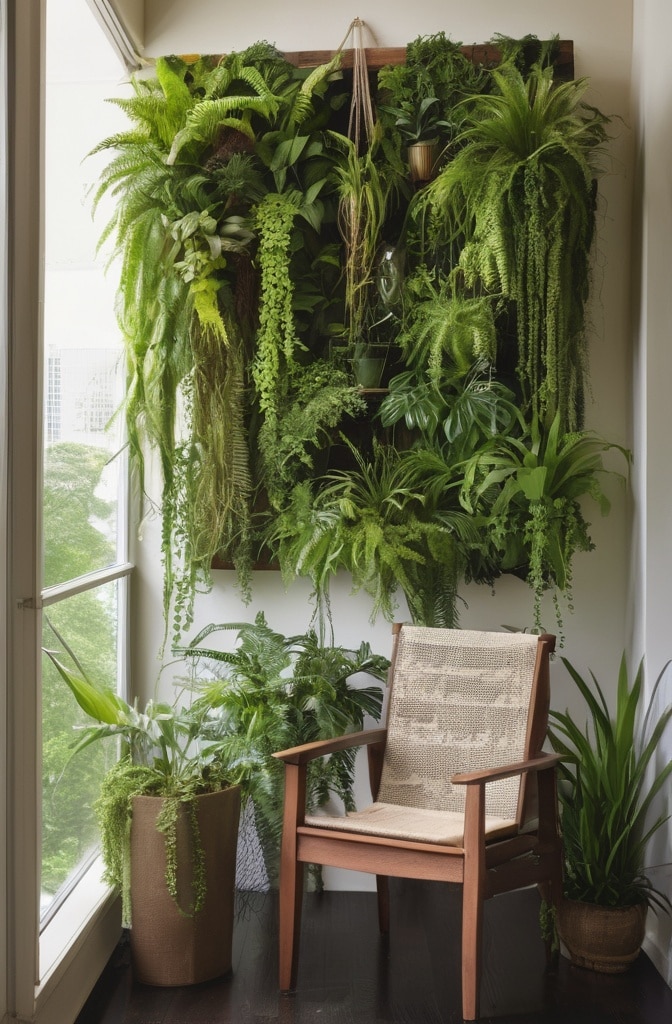
Living greenery brings unmatched vitality to bedroom spaces. Beyond their aesthetic appeal, bedroom plants have been shown to improve air quality and increase humidity levels—beneficial for both sleep quality and skin health.
NASA’s Clean Air Study identified several bedroom-friendly plants that filter common indoor pollutants, including peace lilies, snake plants, and pothos—all of which adapt well to wall-mounted displays.
For successful bedroom plant walls:
- Assess your natural light realistically and choose plants accordingly
- Start with varieties known for easy care (pothos, air plants, and ZZ plants forgive neglect)
- Consider watering logistics carefully—drip trays or self-watering systems protect walls and furniture
- Mix plant varieties for visual interest, combining trailing, upright, and architectural forms
For renters, removable hooks and hanging systems like IKEA’s VAJERT rail system offer plant display solutions without permanent installation.
Light and Reflection Strategies
13. Strategic Mirror Placement for Space Enhancement
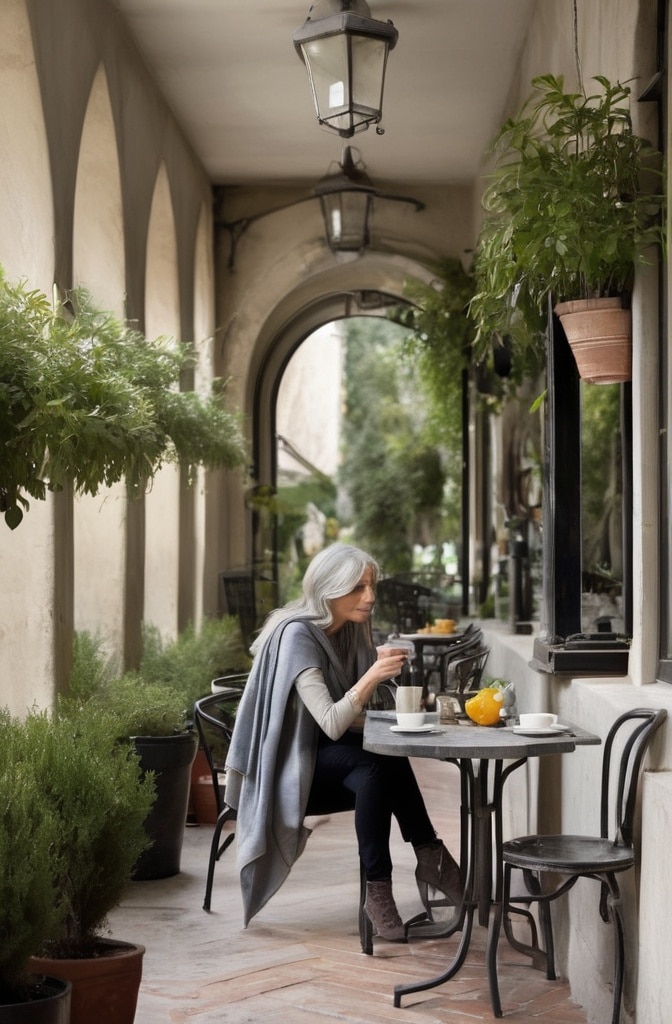
Mirrors perform double duty in bedroom design—expanding visual space while adding decorative impact. Their reflective properties make them particularly valuable in small or dark bedrooms.
“The transformative power of mirrors comes from their ability to multiply light and create visual doorways that extend space,” explains designer Ava Williams.
For maximum effect:
- Position mirrors to reflect natural light sources or attractive views
- Consider decorative frames as part of your overall design scheme
- Experiment with arrangements of multiple smaller mirrors for artistic impact
- Look beyond standard rectangular forms—round, oval, and asymmetrical mirrors add distinctive character
Safety note: Always ensure mirrors are securely mounted using appropriate hardware for their weight, especially in earthquake-prone regions or homes with children.
14. Fairy Lights and String Light Installations
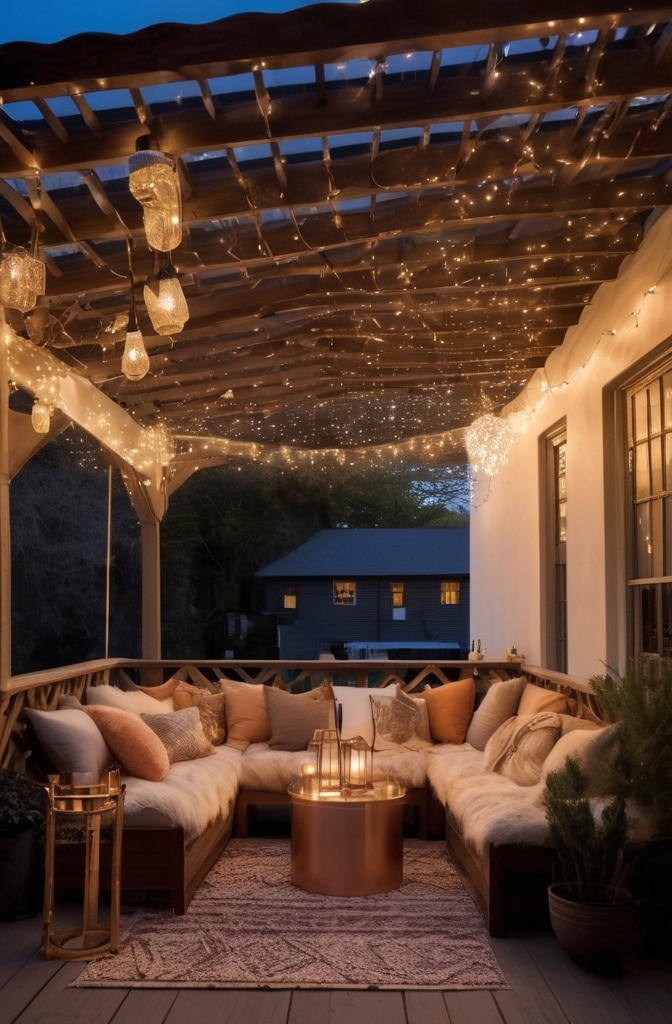
The soft glow of string lights creates an instantly cozy atmosphere that transforms bedroom walls into magical backdrops. These versatile lights have evolved far beyond college dorm decor into sophisticated design elements.
“Light itself is a powerful design material,” notes lighting designer Thomas Chen. “String lights create a diffuse illumination that softens a space and creates emotional warmth.”
Creative applications include:
- Geometric patterns created with nail points and string lights
- Canopy effects when draped from ceiling to wall
- Backlighting for headboards or wall hangings
- Constellation patterns created with micro LED strings
For safety and convenience, look for lights with automatic timers or remote controls, and consider battery-operated options to eliminate visible cords.
15. Wall Sconces and Integrated Lighting Features
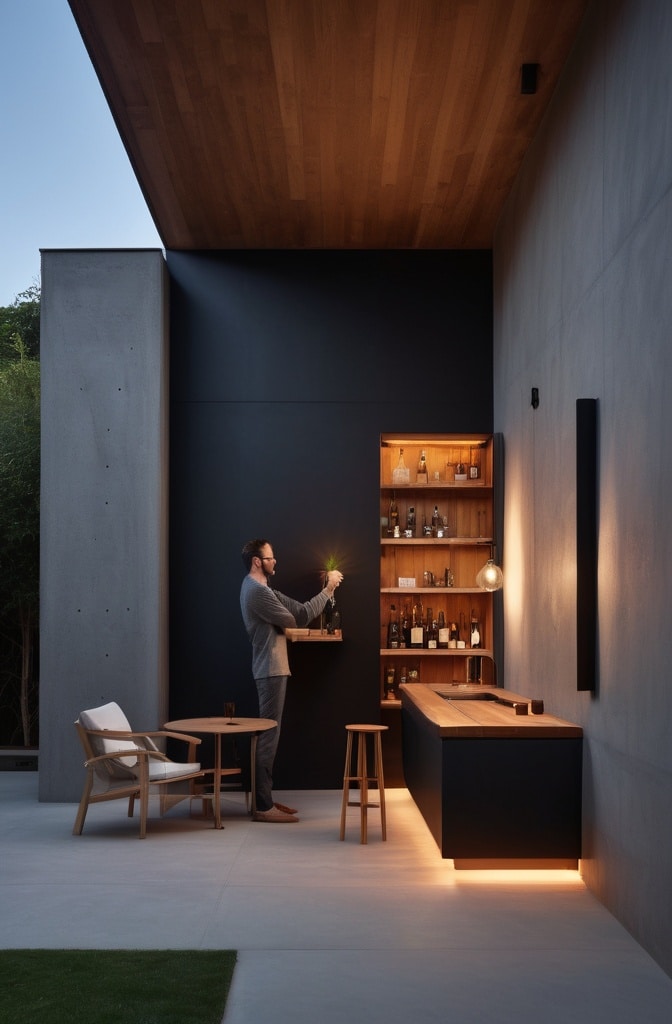
Wall-mounted lighting frees up valuable surface space while providing functional illumination exactly where needed. Modern sconces range from minimalist LED designs to statement pieces that double as sculpture.
“Bedside sconces create symmetry and free nightstand space,” explains lighting designer Jana Peters. “They also provide directional light ideal for reading without disturbing partners.”
When selecting bedroom sconces:
- Consider light temperature—warmer tones (2700-3000K) promote relaxation
- Look for adjustable options that direct light where needed
- For rentals, plug-in sconces with decorative cords offer installation-free solutions
- Position at a height that provides functional light without glare (typically 60-66 inches from the floor)
Recent innovations include sconces with integrated USB charging ports—perfect for keeping devices charged while minimizing cable clutter.
Interactive and Changeable Wall Features
16. Chalkboard and Whiteboard Spaces
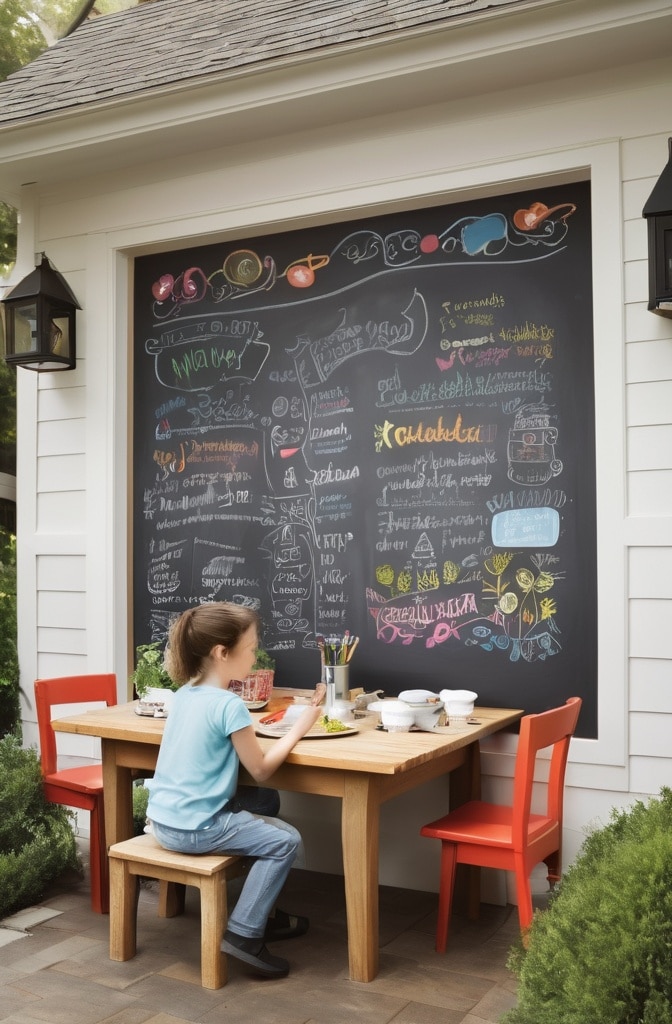
Interactive wall surfaces bring creativity and functionality to bedroom spaces. Whether used for artistic expression, goal setting, or practical reminders, these surfaces add personality and adaptability.
“Interactive walls humanize spaces,” notes environmental psychologist Dr. Marco Fujimoto. “They acknowledge that our needs and thoughts change daily, allowing our environments to respond accordingly.”
To integrate these surfaces elegantly:
- Consider framing chalkboard or whiteboard areas to create intentional design elements
- Use magnetic paint beneath chalkboard paint for additional functionality
- Locate in areas where writing activity won’t disturb sleep (away from the bed)
- Provide attractive storage for writing implements nearby
For low-commitment options, removable chalkboard or whiteboard wallpaper offers similar functionality without permanent installation.
17. Wall Decals for Temporary Transformation
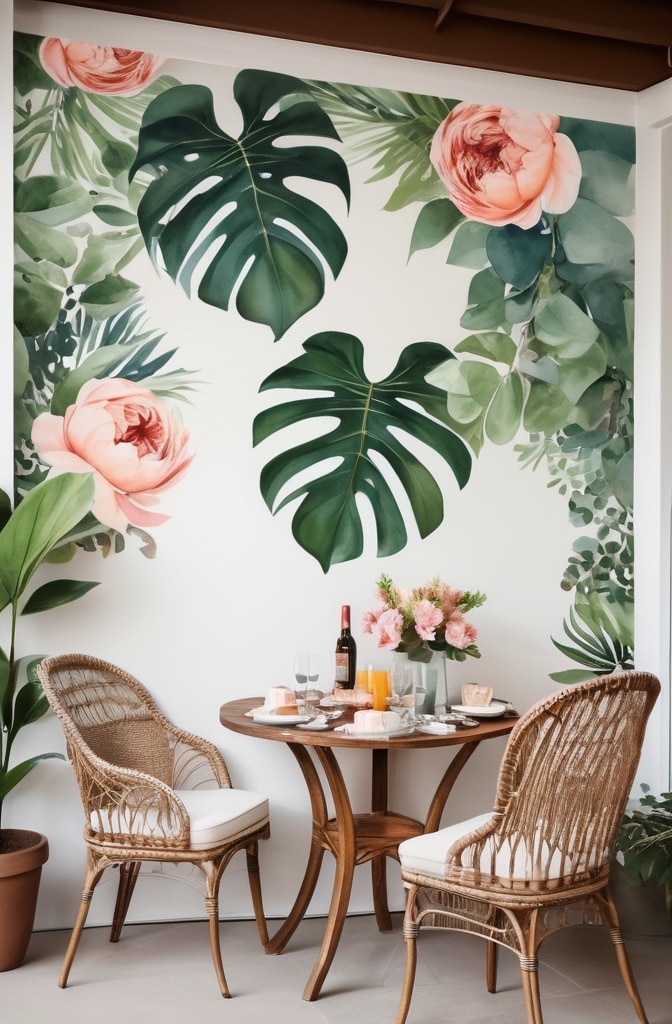
Modern wall decals offer sophisticated design impact with unmatched flexibility. These peel-and-stick elements have evolved dramatically, now available in premium materials with artistic designs suitable for adult spaces.
“Decals allow seasonal refreshes or complete style transformations without significant investment,” explains interior decorator Sophia Lee. “They’re particularly valuable in rental properties or for those who enjoy frequent change.”
When working with decals:
- Prepare surfaces thoroughly—clean, dry, and smooth walls ensure proper adhesion
- Apply with a credit card or squeegee to eliminate air bubbles
- Consider negative space as part of the design—not every inch needs coverage
- Look beyond juvenile designs to sophisticated options like watercolor effects, metallic accents, or abstract shapes
Custom decal creation has become increasingly accessible, with services like Etsy creators offering personalized designs that can transform family photos or original artwork into removable wall features.
18. Geometric Painted Patterns for Visual Interest
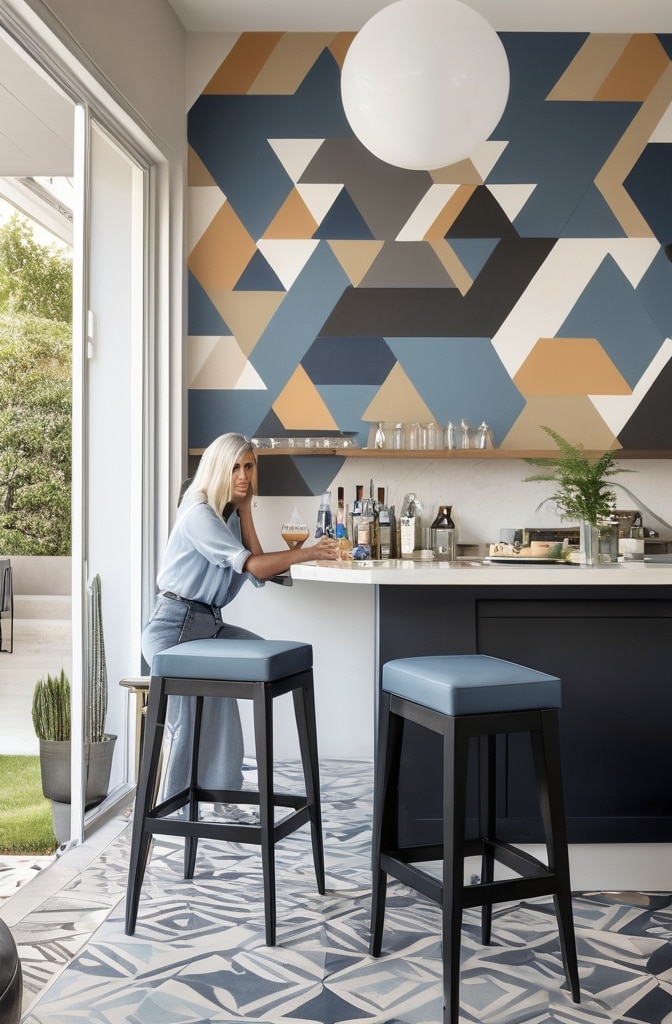
Hand-painted geometric patterns transform walls with personalized artistic impact. These designs can be as simple as color-blocked sections or as complex as intricate tessellations.
“Geometric patterns engage our visual processing in ways that create energy or calm, depending on their complexity and color,” explains color psychologist Dr. Nina Harper.
For successful geometric walls:
- Start with a clear plan and accurate measurements
- Invest in quality painter’s tape for clean lines (FrogTape or ScotchBlue painter’s tape with edge-lock technology)
- Use a level constantly throughout the project
- Consider scale in relation to room size—larger patterns for bigger rooms, smaller for intimate spaces
Painting tip: For the crispest lines, apply a thin coat of the base wall color along tape edges before applying your pattern color. This seals the tape edge and prevents bleeding.
Architectural and Structural Approaches
19. Shiplap and Wood Paneling for Warmth
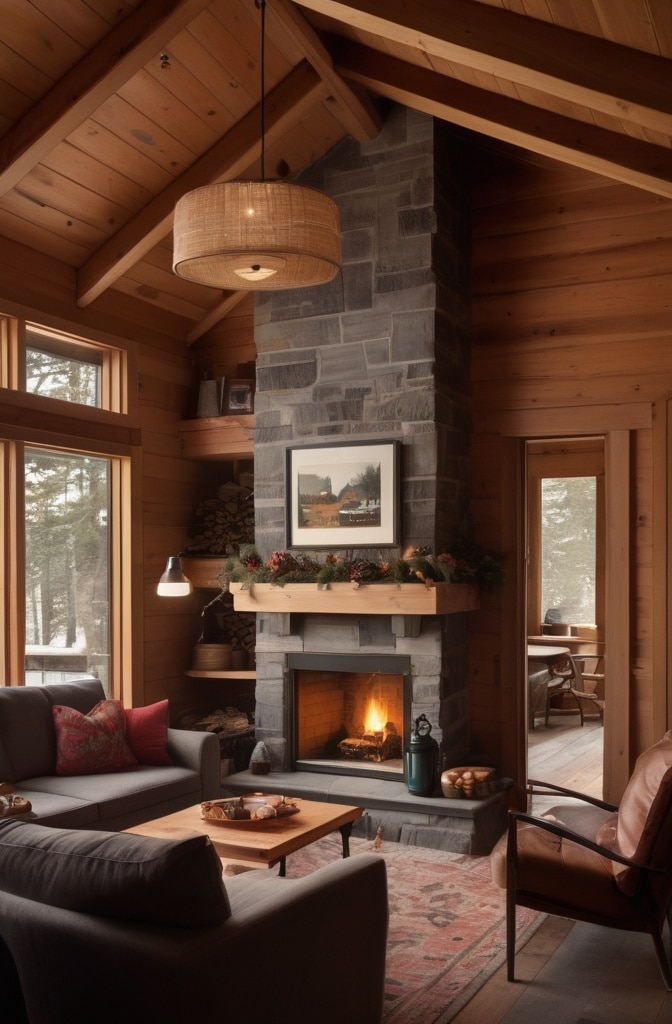
Wood wall treatments bring architectural character and natural warmth to bedroom spaces. Options range from traditional tongue-and-groove paneling to modern interpretations of shiplap and board-and-batten.
Research by the Wood Products Council indicates that visible wood elements in living spaces correlate with reduced stress levels and improved emotional states—ideal qualities for bedroom environments.
“Wood introduces biophilic elements that connect us to nature,” notes sustainable architect Jamie Cortez. “In bedrooms, this creates subconscious comfort that promotes restful sleep.”
When considering wood wall treatments:
- Horizontal installation typically makes rooms feel wider
- Vertical installation draws the eye up, creating perceived height
- Partial installations (half walls or accent areas) offer impact with lower material costs
- Consider prefinished options for faster installation and reduced VOC exposure
For eco-conscious consumers, reclaimed wood offers sustainable character with unique patina impossible to replicate in new materials.
20. Minimalist Frame Arrangements for Calm Spaces
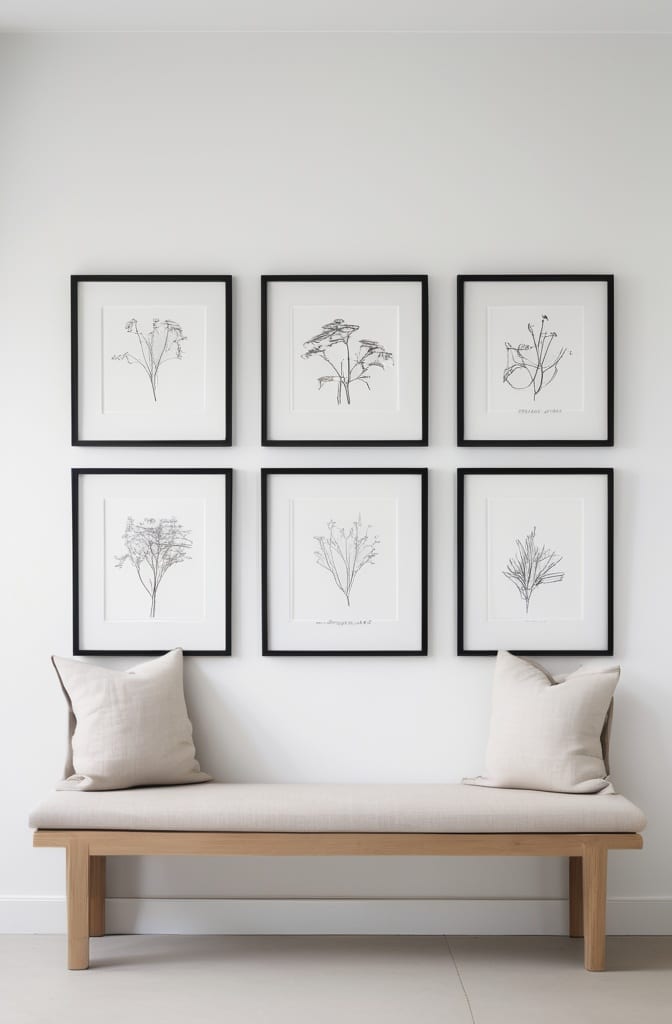
In contrast to busy gallery walls, minimalist frame arrangements create intentional moments of visual focus perfect for serene bedroom environments. This approach values quality over quantity, giving selected pieces room to breathe.
“Negative space is a design element in itself,” explains minimalist designer Tao Lin. “It creates visual rest that’s particularly valuable in sleeping environments.”
For effective minimalist wall arrangements:
- Select fewer, more significant pieces rather than many small ones
- Create intentional asymmetry for subtle visual interest
- Maintain consistent spacing between pieces
- Consider monochromatic artwork for maximum serenity
Frame selection becomes particularly important in minimalist arrangements—choose options that either disappear into the design or make deliberate statements through material or finish.
21. Wall-Mounted Storage as Decorative Elements
Functional storage elements can double as artistic wall features when thoughtfully selected and arranged. This approach is particularly valuable in smaller bedrooms where floor space is limited.
“Vertical storage solutions free up valuable floor space while creating visual interest,” notes small-space design expert Claudia Herrera. “The key is selecting pieces with both functional excellence and aesthetic appeal.”
Effective wall-mounted storage includes:
- Floating nightstands that eliminate the need for traditional bedside tables
- Modular shelving systems that can evolve with changing storage needs
- Decorative hooks and hanging organizers for frequently used items
- Custom niches built between wall studs for maximum space efficiency
Look for pieces with clean lines and materials that complement your overall design scheme—natural woods, powder-coated metals, and acrylic all offer distinctive looks with practical functionality.
22. Abstract Art Installations for Modern Sophistication
Abstract art liberates bedroom walls from literal representation, creating emotional impact through color, form, and composition. These pieces often become more personally meaningful over time as viewers develop their own relationships with non-representational works.
“Abstract art invites ongoing engagement,” explains gallery curator Marcus Zhang. “In bedrooms, this creates a dynamic element that remains fresh because it never resolves into a single definitive meaning.”
When selecting abstract art:
- Pay attention to your emotional response rather than intellectual understanding
- Consider how colors harmonize with or intentionally contrast your decor
- Think about the energy of the piece—bedrooms typically benefit from works with some restful elements
- Look beyond paintings to sculptural wall installations for three-dimensional impact
For budget-friendly abstract art, consider student shows at local art schools, where emerging artists offer fresh perspectives at accessible price points.
Practical Implementation Guide
Transforming your bedroom walls should be a joyful process of self-expression, not an overwhelming project. Consider these practical steps:
- Start with assessment: Take photos of your current space and note what’s working and what’s not. Define your goals clearly before making purchases.
- Create a cohesive plan: Develop a complete vision rather than making piecemeal decisions. Use Pinterest boards or design apps to visualize how elements will work together.
- Budget strategically: Invest in 1-2 significant pieces that anchor your design, then supplement with more affordable elements.
- Consider phased implementation: You don’t need to transform everything at once. Start with the wall behind your bed for maximum impact, then expand your treatment to other walls over time.
- Gather proper tools: Having the right equipment—stud finders, levels, appropriate anchors, and quality hanging hardware—saves time and prevents wall damage.
Remember that your bedroom should ultimately reflect your personal needs and preferences. The most successful bedroom walls create environments that support rest, inspiration, and wellbeing tailored specifically to you.
Conclusion
Your bedroom walls offer canvas for personal expression unlike any other space in your home. Through thoughtful decoration, these surfaces can transform your entire experience of the room, creating environments that nurture rest, inspiration, and wellbeing.
The 22 ideas we’ve explored represent starting points rather than rigid prescriptions. The most successful bedroom walls combine elements in unique ways that reflect individual personalities and needs.
Whether you’re drawn to dramatic statement walls, personalized galleries, textural elements, or architectural treatments, the key lies in intentional choices that create meaningful connections with your most personal space.
What wall decoration approach resonates most deeply with you? Whatever direction you choose, remember that your bedroom should ultimately tell your story—and your walls provide the perfect pages on which to write it.
